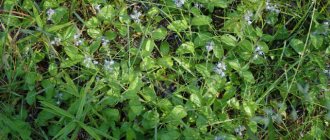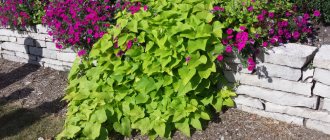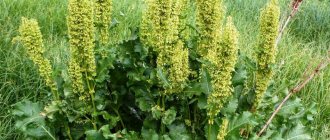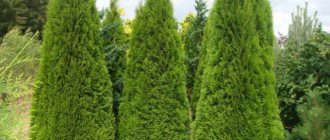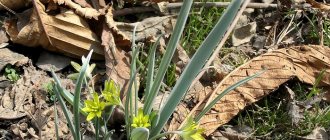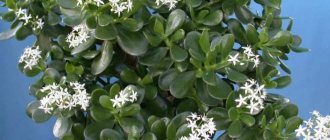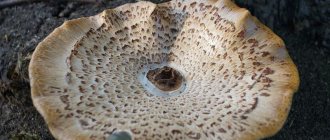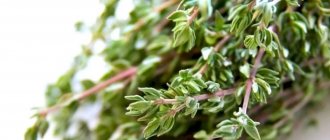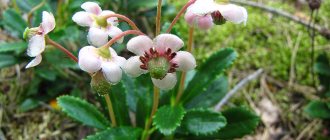Botanical description
The initial plant is a perennial herb that grows in the wild.
Grass can also grow in summer cottages if simple care rules are followed.
Botanical features of the culture:
- The root system is thick, but short. There is one tap root and several branches.
- The stem is erect and grows up to a meter in height.
- The leaves have a lacy shape and a rough surface on both sides. They can be oval or heart-shaped. The leaves are small in size.
- The flowering process occurs from July to August. Inflorescences form at the top of the plant. They are strewn with small bell-shaped flowers. The color of the inflorescences is usually purple, sometimes lilac or white.
- During the ripening period, fruits are formed, consisting of 4 nuts located at the bottom of the cup. They have a brownish tint. Their ripening occurs from August to October.
The initial letter has a rather specific smell, which can be felt if you rub the leaves with your hands.
The letter grows in the wild and can be easily grown at home.
Chemical composition
The medicinal properties of the initial cap are due to the presence of valuable components in the raw material. Stachys marsh and other plant varieties are sources of the following beneficial substances:
- flavonoids;
- organic acids;
- sugar;
- pectins;
- tannins;
- choline;
- essential oils;
- resins;
- alkaloids.
Seeds of capitol contain about 40% fatty oils. It is known that the aerial parts of the plant are rich in betaine bases.
Pharmacological properties
Useful properties of the initial letter:
- Suppresses inflammatory processes in the body.
- Has a choleretic effect.
- Helps in the treatment of the respiratory tract, produces an expectorant effect.
- Calms the central nervous system.
- Reduces high blood pressure.
- Reduces pain.
- Normalizes metabolic processes.
- Stabilizes the digestive process.
- Restores normal blood circulation in the body.
The plant is practically not used in traditional medicine, but is actively used by folk healers.
The initial letter is widely used in folk medicine
Photo of medicinal initial letter
Read here! Lyubka bifolia - medicinal properties and the best recipes from traditional medicine (110 photos)
Please repost
0
Use in folk medicine
The letter is used to treat various pathological conditions, for example, with:
- poor psycho-emotional background;
- liver dysfunction;
- disruptions in the blood circulation process;
- joint diseases;
- headaches;
- cuts, wounds;
- heartburn;
- neuralgia;
- gallstones.
This herb also has a good tonic effect and helps improve the general condition of the body.
Chinese herbalists actively drink tea based on it.
In Austrian medicine, the plant is used to treat pathologies of the respiratory tract, digestive organs, women's diseases and the nervous system.
The initial letter is used in the treatment of many pathological conditions
Kinds
The genus is represented by about 15 species that are found in temperate regions of both hemispheres.
Officinalis (lat. B. officinalis) is found among forbs in meadows and hills of the European part of Russia, as well as in bush thickets and forest clearings. The plant is recognized in the pharmacopoeia of European countries and is used in Tibetan medicine. This is an ancient healing remedy that has retained its relevance to this day.
Initial letter in natural conditions
The herb is collected during flowering for medicinal purposes; the roots are used less frequently. The herbal preparation has few contraindications, but it has more than enough beneficial properties. The choleretic, anti-inflammatory, expectorant effect of the drop cap is known. Preparations prepared on the basis of herbs have an analgesic, calming effect, lower blood pressure, normalize metabolism, stabilize digestion and blood circulation. Teas and decoctions are used for nervous excitability, migraines, dizziness and epilepsy. It is also used for cosmetic purposes, turning pale girls into rosy beauties.
The plant is deservedly considered an excellent honey plant, so it is advisable to place it in the pharmacy garden. Bees attracted to the site will also look into the flowers of strawberries, cucumbers and other garden plants, significantly increasing the chances of a good harvest through pollination.
Grandiflora (lat. B. grandiflora) is a plant of subalpine meadows. It is found naturally in the Caucasus and Asia Minor countries. It is not only unpretentious, but also very decorative. The height of the plant is determined by the size of the leaves; it does not exceed an average of 30 cm. The height of the leafless peduncle reaches up to half a meter. It is distinguished by short decorative capitate inflorescences and spectacular dark green crenate leaves that retain their beauty and splendor until frost.
Recipes
As mentioned above, the plant is not used in traditional medicine. But in herbal medicine there are many recipes based on this plant. Many different remedies are prepared with the initial letter.
Tea
To prepare, take a teaspoon of the dry plant, pour in 250 ml of boiling water, and leave to infuse for 15 minutes. Then filter.
Drink half a glass 3 times daily.
The product is also used for gargling.
Tea preparation from dried initial letter
Infusion of leaves
The infusion is prepared as follows: take a tablespoon of dried herb and pour 250 ml of boiling water.
Next, the drink is infused for 1.5 hours and filtered.
Take a tablespoon three times a day on an empty stomach.
Root-based decoction
To prepare 20 g of dried roots, brew 200 ml of boiling water and place on the stove for 20 minutes. Then the liquid is filtered. Take a tablespoon three times a day.
Infusion of leaves and roots
Take a tablespoon of leaves and roots mixed in equal quantities. Pour the mixture with a glass of cool but boiled water. Let it brew for 2 hours, then strain. Take a large spoon three times a day.
Leaves of the medicinal letter
Herbal tincture
To prepare, pour 2 tablespoons of the herb into a glass of boiling water.
Place on low heat and cook for 5 minutes, then leave for 30 minutes and strain.
Next, add 40 g of port to the infusion.
Take 70 ml three times a day.
To obtain a high therapeutic effect, it is necessary to use folk remedies for a long time. After all, the plant acts slowly. It is important not to exceed the recommended dosage, otherwise stomach upset may occur.
Medicinal teas, infusions, and decoctions are prepared from the initial letter.
Contraindications
It is not allowed to take funds based on a drop cap in the following cases:
- low blood pressure;
- gastritis;
- bearing a child;
- thrombus formation.
It is not recommended to use the herb when treating with medications for changes in blood pressure.
Dosage forms
The whole plant has healing properties, so in the summer the above-ground part is collected. And herbalists recommend digging up the root in late autumn.
Depending on the effect that needs to be achieved, different means are prepared. Some recipes add additional ingredients.
In what conditions to grow
The initial plant can be grown in summer cottages; it does not cause any difficulties. The plant is not a fastidious crop and is highly resistant to low temperatures.
It can grow on different soils, even infertile ones.
But if you take special care of the drop cap, it is better to plant it in loamy soil. The fact is that exactly this type of soil is found in the forests where this crop grows.
The landing location is also not particularly important. The grass feels great when exposed to sunlight and in the shade. But when planted in a sunny place, the stem will stretch, this is worth taking into account. The bushes turn out to be tall.
It is enough to water the crop once a week.
If the soil is waterlogged, the risk of slug attack and loss of the decorative qualities of the plant increases.
It is not necessary to feed, but if desired, it is allowed to apply fertilizer only three times per season:
- In the spring, when the first shoots sprout, use a universal fertilizer.
- Before flowering begins, mineral fertilizers are suitable.
- At the end of flowering, it is recommended to apply nitrogen fertilizers.
Without feeding, the droplet will not die, and will not even get sick, but with it it will be possible to grow the most beautiful and lush plant.
The initial letter can become a decoration for any garden
Reproduction
The initial plant reproduces by seeds and vegetatively. The vegetation method involves dividing the bush. Usually the procedure is carried out in the spring. You can do this in the fall, but there is no guarantee that the grass will take root well.
Only adult plants are allowed to propagate using this method.
It is important that they bloom for more than one year. For cuttings, shoots at least 10 cm long are used.
Reproduction by seeds does not require cold stratification. But it is recommended to plant them before winter, then truly strong plants that are resistant to external conditions will grow.
During spring planting, germination rate decreases and the emergence of sprouts slows down.
Sowing is carried out in furrows to a depth of 2 cm.
Young plant
